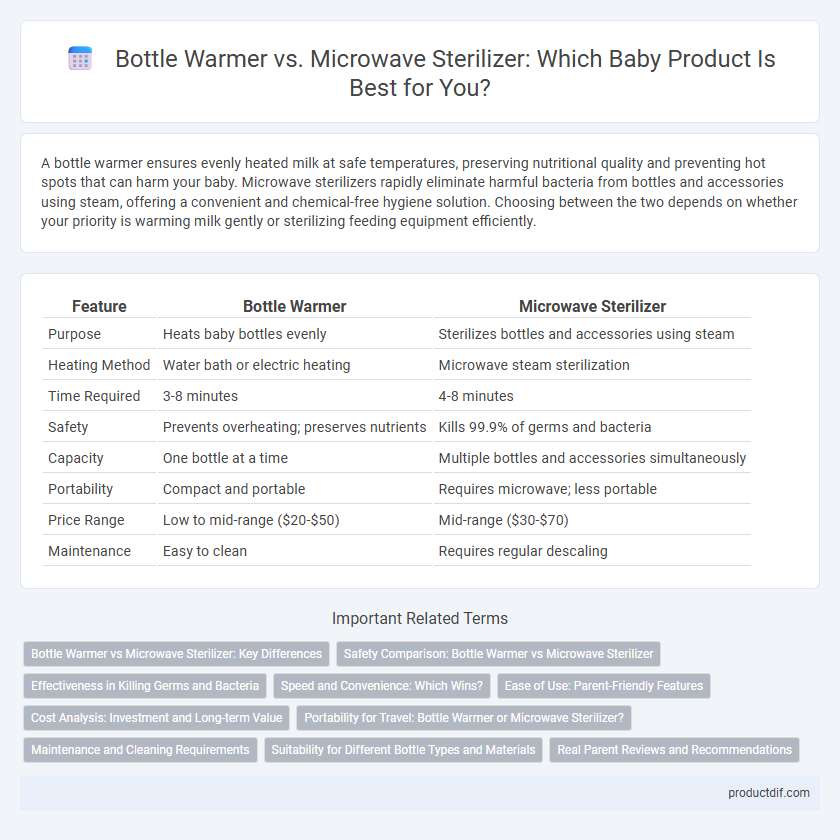A bottle warmer ensures evenly heated milk at safe temperatures, preserving nutritional quality and preventing hot spots that can harm your baby. Microwave sterilizers rapidly eliminate harmful bacteria from bottles and accessories using steam, offering a convenient and chemical-free hygiene solution. Choosing between the two depends on whether your priority is warming milk gently or sterilizing feeding equipment efficiently.
Table of Comparison
| Feature | Bottle Warmer | Microwave Sterilizer |
|---|---|---|
| Purpose | Heats baby bottles evenly | Sterilizes bottles and accessories using steam |
| Heating Method | Water bath or electric heating | Microwave steam sterilization |
| Time Required | 3-8 minutes | 4-8 minutes |
| Safety | Prevents overheating; preserves nutrients | Kills 99.9% of germs and bacteria |
| Capacity | One bottle at a time | Multiple bottles and accessories simultaneously |
| Portability | Compact and portable | Requires microwave; less portable |
| Price Range | Low to mid-range ($20-$50) | Mid-range ($30-$70) |
| Maintenance | Easy to clean | Requires regular descaling |
Bottle Warmer vs Microwave Sterilizer: Key Differences
Bottle warmers primarily focus on gently heating milk to the ideal feeding temperature, preserving nutrients and preventing hot spots, while microwave sterilizers use microwave energy to rapidly eliminate bacteria and germs on bottles and accessories. The bottle warmer offers precise temperature control and is often designed for single bottles, whereas microwave sterilizers provide a quick and efficient sterilization process for multiple items simultaneously. Parents seeking convenience and safety during feeding often choose a bottle warmer for warming and a microwave sterilizer for thorough cleaning, highlighting their complementary roles in baby care.
Safety Comparison: Bottle Warmer vs Microwave Sterilizer
Bottle warmers provide a controlled and consistent heating environment that significantly reduces the risk of overheating and nutrient loss, ensuring safer preparation of baby milk. Microwave sterilizers, while convenient, may create uneven heat distribution, potentially leaving harmful bacteria on baby bottles if not used correctly. Prioritizing safety, bottle warmers offer more reliable temperature regulation, minimizing risks associated with microwave sterilization.
Effectiveness in Killing Germs and Bacteria
Bottle warmers primarily focus on gently heating milk and do not effectively kill germs or bacteria, whereas microwave sterilizers utilize high heat and steam to eradicate up to 99.9% of harmful microorganisms on baby bottles and accessories. Scientific studies confirm that microwave sterilizers reach temperatures sufficient to destroy common pathogens such as E. coli, Salmonella, and Staphylococcus, ensuring a hygienic feeding environment. Choosing a microwave sterilizer offers a more reliable solution for maintaining baby bottle sanitation compared to bottle warmers, which lack sterilization capabilities.
Speed and Convenience: Which Wins?
Bottle warmers heat milk rapidly with consistent temperature control, offering unmatched speed for busy parents. Microwave sterilizers cleanse multiple items simultaneously within minutes, providing convenience for thorough hygiene. Choosing between them depends on whether quick feeding preparation or comprehensive sterilization is the priority.
Ease of Use: Parent-Friendly Features
Bottle warmers offer parent-friendly features such as one-touch operation and precise temperature control, ensuring quick and safe warming without guesswork. Microwave sterilizers provide a convenient and fast solution for sterilizing multiple items simultaneously, often requiring minimal assembly and time. Both devices simplify daily routines, but bottle warmers excel in delivering consistent warmth tailored for feeding, while microwave sterilizers prioritize thorough disinfection.
Cost Analysis: Investment and Long-term Value
Bottle warmers typically require a lower initial investment, ranging from $20 to $50, while microwave sterilizers cost between $30 and $70. Long-term value depends on usage frequency; bottle warmers provide consistent warming efficiency, reducing wasted formula, whereas microwave sterilizers offer multipurpose sterilization, potentially lowering expenses on disposable sterilizing items. Evaluating cost-effectiveness involves considering both upfront purchase price and ongoing benefits like time saved and product durability.
Portability for Travel: Bottle Warmer or Microwave Sterilizer?
Bottle warmers are highly portable and designed for easy use during travel, often powered by car adapters or batteries, making them ideal for warming milk on the go. Microwave sterilizers, while effective at sterilizing multiple items quickly, require access to a microwave, limiting their portability and convenience in travel scenarios. For parents prioritizing lightweight, standalone convenience, bottle warmers offer superior portability compared to microwave sterilizers.
Maintenance and Cleaning Requirements
Bottle warmers require minimal cleaning, typically involving wiping the heating element and descaling with vinegar to prevent mineral buildup. Microwave sterilizers demand thorough washing of all parts after each use to remove milk residue and ensure effective sterilization. Regular maintenance of both devices is essential to maintain hygiene and prolong their lifespan in baby care routines.
Suitability for Different Bottle Types and Materials
Bottle warmers and microwave sterilizers cater to different needs based on bottle types and materials. Bottle warmers provide gentle, consistent heat suitable for glass, plastic, and silicone bottles without risk of warping or melting. Microwave sterilizers efficiently sanitize various bottle materials but may cause deformation in thinner plastics, making bottle warmers more versatile for delicate or heat-sensitive bottles.
Real Parent Reviews and Recommendations
Real parent reviews reveal that bottle warmers consistently provide even heating without hotspots, ensuring safer feeding experiences compared to microwave sterilizers. Many parents recommend bottle warmers for their simplicity, reliability, and preservation of nutrient integrity, while microwave sterilizers often receive mixed feedback due to uneven sterilization and plastic odor concerns. User testimonials emphasize the convenience of bottle warmers in busy routines, highlighting their preference for consistent temperature control and ease of use over the quicker but sometimes unpredictable microwave sterilization.
Bottle warmer vs microwave sterilizer Infographic

 productdif.com
productdif.com